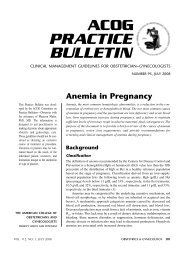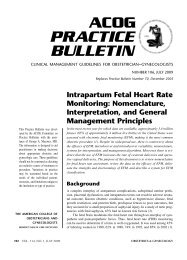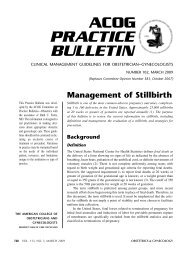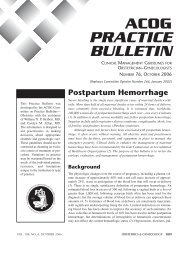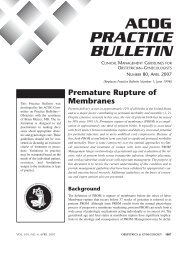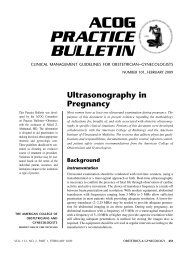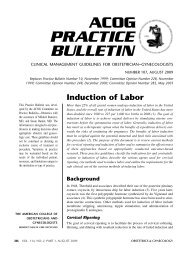dose reduction may be considered to further decrease thechance of anaphylaxis. Risk–benefit considerations donot usually favor beg<strong>in</strong>n<strong>in</strong>g allergen immunotherapydur<strong>in</strong>g pregnancy.What is appropriate rescue therapy for asthmadur<strong>in</strong>g pregnancy?Inhaled short-act<strong>in</strong>g β 2-agonists are the rescue therapy ofchoice for asthma dur<strong>in</strong>g pregnancy. Inhaled albuterol isthe first-choice, short-act<strong>in</strong>g β 2-agonist for pregnantwomen, although other agents also may be appropriate.In general, patients should use up to two treatments of<strong>in</strong>haled albuterol (two to six puffs) or nebulized albuterolat 20-m<strong>in</strong>ute <strong>in</strong>tervals for most mild to moderate symptoms;higher doses can be used for severe symptom exacerbation.To avoid maternal and fetal hypoxia, patientsshould be counseled to start rescue therapy at home whenthey have an exacerbation of symptoms, such as cough<strong>in</strong>g,chest tightness, dyspnea, wheez<strong>in</strong>g, or a 20% decrease<strong>in</strong> the PEFR. With a good response (ie, symptoms reduceor resolve, and the PEFR reaches 80% of personal best)the patient can cont<strong>in</strong>ue normal activity. If the patientdoes not have a good response or if she notices adecrease <strong>in</strong> fetal activity, she should seek medical attentionquickly.What is first-l<strong>in</strong>e controller therapy for asthmadur<strong>in</strong>g pregnancy?For those with mild, <strong>in</strong>termittent asthma, no controllertherapy is <strong>in</strong>dicated. Use of <strong>in</strong>haled corticosteroids is firstl<strong>in</strong>econtroller therapy for persistent asthma dur<strong>in</strong>g pregnancy.For patients with mild, persistent asthma, the use oflow-dose <strong>in</strong>haled corticosteroids is recommended (see thebox). For patients with moderate persistent asthma orwhose symptoms are not controlled with the use of lowdose<strong>in</strong>haled corticosteroids, the use of medium-dose<strong>in</strong>haled corticosteroids or low-dose <strong>in</strong>haled corticosteroidsand long-act<strong>in</strong>g β-agonists are <strong>in</strong>dicated. SeeTable 2 for typical <strong>in</strong>haled corticosteroid regimens.Budesonide is the preferred <strong>in</strong>haled corticosteroid for usedur<strong>in</strong>g pregnancy (4). However, there are no data <strong>in</strong>dicat<strong>in</strong>gthat the other <strong>in</strong>haled corticosteroid preparations areunsafe dur<strong>in</strong>g pregnancy. Therefore, the use of any <strong>in</strong>haledcorticosteroids may be cont<strong>in</strong>ued <strong>in</strong> patients whose asthmawas well controlled by these agents before pregnancy (4).What is appropriate add-on controller therapyfor asthma dur<strong>in</strong>g pregnancy?Use of long-act<strong>in</strong>g β 2-agonists is the preferred add-oncontroller therapy for asthma dur<strong>in</strong>g pregnancy. Thistherapy should be added when patients’ symptoms areStep Therapy Medical Managementof <strong>Asthma</strong> Dur<strong>in</strong>g <strong>Pregnancy</strong>Mild Intermittent <strong>Asthma</strong>• <strong>No</strong> daily medications, albuterol as neededMild Persistent <strong>Asthma</strong>• Preferred—Low-dose <strong>in</strong>haled corticosteroid• Alternative—Cromolyn, leukotriene receptor antagonist,or theophyll<strong>in</strong>e (serum level 5–12 mcg/mL)Moderate Persistent <strong>Asthma</strong>• Preferred—Low-dose <strong>in</strong>haled corticosteroid andsalmeterol or medium-dose <strong>in</strong>haled corticosteroidor (if needed) medium-dose <strong>in</strong>haled corticosteroidand salmeterol• Alternative—Low-dose or (if needed) mediumdose<strong>in</strong>haled corticosteroid and either leukotrienereceptor antagonist or theophyll<strong>in</strong>e (serum level5–12 mcg/mL)Severe Persistent <strong>Asthma</strong>• Preferred—High-dose <strong>in</strong>haled corticosteroid andsalmeterol and (if needed) oral corticosteroid• Alternative—High-dose <strong>in</strong>haled corticosteroid andtheophyll<strong>in</strong>e (serum level 5–12 mcg/mL) and oralcorticosteroid if needednot controlled with the use of medium-dose <strong>in</strong>haled corticosteroids.Alternative add-on therapies are theophyll<strong>in</strong>eor leukotriene receptor antagonists (montelukast, zafirlukast).However, the use of long-act<strong>in</strong>g <strong>in</strong>haled β 2-agonistsis preferred because it has been shown to be a moreeffective add-on therapy <strong>in</strong> nonpregnant patients thanleukotriene receptor antagonists or theophyll<strong>in</strong>e. Longact<strong>in</strong>g<strong>in</strong>haled β 2-agonists have fewer side effects thantheophyll<strong>in</strong>e, which has a narrow therapeutic <strong>in</strong>dex andrequires serum monitor<strong>in</strong>g, and there are few data on theuse of leukotriene receptor antagonists <strong>in</strong> humans dur<strong>in</strong>gpregnancy. See Table 2 for typical medication dosages.Because long-act<strong>in</strong>g and short-act<strong>in</strong>g <strong>in</strong>haled β 2-agonistshave similar pharmacology and toxicology, long-act<strong>in</strong>g<strong>in</strong>haled β 2-agonists are expected to have a safety profilesimilar to that of albuterol. Two long-act<strong>in</strong>g <strong>in</strong>haledβ 2-agonists are available: 1) salmeterol and 2) formoterol.Limited observational data exist on their use dur<strong>in</strong>g pregnancy.A step-wise approach to management is advised <strong>in</strong>order to achieve control. See the box for specific therapy.For patients whose symptoms are not well controlled(Table 1) with the use of medium-dose <strong>in</strong>haled corticosteroidsand long-act<strong>in</strong>g <strong>in</strong>haled β 2-agonists, treatmentshould be advanced to high-dose <strong>in</strong>haled corticosteroids460 <strong>ACOG</strong> <strong>Practice</strong> <strong>Bullet<strong>in</strong></strong> <strong>Asthma</strong> <strong>in</strong> <strong>Pregnancy</strong> OBSTETRICS & GYNECOLOGY
Table 2. Comparative Daily Doses for Inhaled Corticosteroids*Corticosteroid Amount Low Dose Medium Dose High DoseBeclomethasone HFA 40 mcg per puff 2–6 puffs More than 6–12 puffs More than 12 puffs80 mcg per puff 1–3 puffs More than 3–6 puffs More than 6 puffsBudesonide 200 mcg per <strong>in</strong>halation 1–3 puffs More than 3–6 puffs More than 6 puffsFlunisolide 250 mcg per puff 2–4 puffs 4–8 puffs More than 8 puffsFluticasone HFA 44 mcg per puff 2–6 puffs110 mcg per puff 2 puffs 2–4 puffs More than 4 puffs220 mcg per puff 1–2 puffs More than 2 puffsFluticasone DPI 50 mcg per <strong>in</strong>halation 2–6 puffs100 mcg per <strong>in</strong>halation 1–3 puffs 3–5 puffs More than 5 puffs250 mcg per <strong>in</strong>halation 1 puff 2 puffs More than 2 puffsMometasone 200 mcg per <strong>in</strong>halation 1 puff 2 puffs More than 2 puffsTriamc<strong>in</strong>olone 75 mcg per puff 4–10 puffs 10–20 puffs More than 20 puffs*Total daily puffs is usually divided <strong>in</strong>to a twice-per-day regimen.Abbreviations: DPI, dry powder <strong>in</strong>haler; HFA, hydrofluoroalkaneAdapted from National Heart, Lung, and Blood Institute, National <strong>Asthma</strong> Education and Prevention Program. Expert panel report 3: guidel<strong>in</strong>esfor the diagnosis and management of asthma. NIH Publication <strong>No</strong>. 07-4051. Bethesda (MD): NHLBI; 2007. Available at:http://www.nhlbi.nih.gov/guidel<strong>in</strong>es/asthma/asthgdln.htm. Retrieved September 10, 2007.(Table 2) and long-act<strong>in</strong>g <strong>in</strong>haled β 2-agonists (salmeterol,one puff twice daily). Some patients with severe asthmamay require regular oral corticosteroid use to achieve adequateasthma control. For patients whose symptoms arevery poorly controlled (Table 1), a course of oral corticosteroidsmay be necessary to atta<strong>in</strong> control, along with astep up <strong>in</strong> therapy, as described previously and <strong>in</strong> the box.What nonpharmacologic approaches shouldbe used for asthma dur<strong>in</strong>g pregnancy?Identify<strong>in</strong>g and controll<strong>in</strong>g or avoid<strong>in</strong>g factors, such asallergens and irritants, that contribute to asthma severity,particularly tobacco smoke, can lead to improved maternalwell-be<strong>in</strong>g with less need for medication (4). If gastroesophagealreflux is exacerbat<strong>in</strong>g the patient’s asthma,nonpharmacologic measures, such as elevat<strong>in</strong>g the headof the bed, eat<strong>in</strong>g smaller meals, not eat<strong>in</strong>g with<strong>in</strong> 2–3hours of bedtime, and avoid<strong>in</strong>g trigger<strong>in</strong>g foods, mayhelp. <strong>Asthma</strong> control is enhanced by ensur<strong>in</strong>g access toeducation about asthma, the <strong>in</strong>terrelationships betweenasthma and pregnancy, and the skills necessary to manageasthma. These skills <strong>in</strong>clude self-monitor<strong>in</strong>g, correctuse of <strong>in</strong>halers, follow<strong>in</strong>g a plan for long-term managementof asthma, and promptly handl<strong>in</strong>g signs of worsen<strong>in</strong>gasthma (4). Specific measures to reduce mold, dustmite exposure, animal dander, cockroaches, and otherenvironmental triggers may be important. Animal dandercontrol entails remov<strong>in</strong>g the animal from the home or, ata m<strong>in</strong>imum, keep<strong>in</strong>g the animal out of the patient’s bedroom.Cockroaches can be controlled by poison or baittraps and elim<strong>in</strong>at<strong>in</strong>g exposed food or garbage.How should asthma therapy be adjusteddur<strong>in</strong>g pregnancy?The step-care therapeutic approach <strong>in</strong>creases the numberand dosage of medications with <strong>in</strong>creas<strong>in</strong>g asthma severity(see the box). At each step of therapy, medications areconsidered to be “preferred” or “alternative” based onefficacy and safety considerations. Patients whose symptomsare not optimally respond<strong>in</strong>g to treatment shouldreceive a step up <strong>in</strong> treatment to more <strong>in</strong>tensive medicaltherapy. Once control is achieved and susta<strong>in</strong>ed for severalmonths, a step-down approach can be considered, buta change <strong>in</strong> therapy should be undertaken cautiously andadm<strong>in</strong>istered gradually to avoid compromis<strong>in</strong>g the stabilityof the asthma control. For some patients, it may be prudentto postpone, until after birth, a reduction of therapythat is effectively controll<strong>in</strong>g the patient’s asthma (4).How should acute asthma be assessed dur<strong>in</strong>gpregnancy?Initial assessment of a pregnant patient present<strong>in</strong>g withacute asthma <strong>in</strong>cludes obta<strong>in</strong><strong>in</strong>g a brief medical history,perform<strong>in</strong>g a physical exam<strong>in</strong>ation, and exam<strong>in</strong><strong>in</strong>g physiologicmeasures of airway function and fetal well-be<strong>in</strong>g.Pulmonary physiologic assessment <strong>in</strong>cludes measur<strong>in</strong>gFEV 1or PEFR and oxygen saturation. Fetal assessmentVOL. 111, NO. 2, PART 1, FEBRUARY 2008 <strong>ACOG</strong> <strong>Practice</strong> <strong>Bullet<strong>in</strong></strong> <strong>Asthma</strong> <strong>in</strong> <strong>Pregnancy</strong> 461



